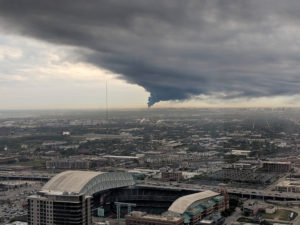
As a towering plume of black smoke billowed a mile above Houston for a third day, local officials said they don’t know how long the petrochemical blaze that sent orange fireballs into the sky will continue.
Five tanks holding gasoline ingredients were still afire about 20 miles (32 kilometers) east of downtown Houston on Tuesday and three have burned out, according to facility owner Intercontinental Terminals Co. However, previous expectations that the conflagration would exhaust itself by the middle of the week no longer hold, officials said.
The fire that began early Sunday in an industrial suburb called Deer Park intensified overnight after a dip in water pressure interfered with firefighting efforts and two more tanks erupted in flame. The pressure drop has been rectified and additional help in fighting the fire was summoned.
“Fuel has burned off and we’ve said from the beginning that may be what has to happen,” Harris County Fire Marshal Laurie Christensen said during a meeting with reporters. “I’m not going to give you a time because as we know overnight it has changed.”
Ground Level
In the downtown Houston business district, the smoky smell that pervaded high-rise offices on Monday had eased. But in residential neighborhoods on the city’s north side, a chemical odor descended Tuesday morning on an otherwise clear day. An ITC spokeswoman said air pollution remained below health-concern levels.
Since assuring residents of the fourth-largest U.S. city on Monday that there were no “immediate health concerns at ground level,” the Texas Commission on Environmental Quality hasn’t issued any new advisories or assessments. The agency doesn’t know when it will issue an update, spokesman Brian McGovern said in a telephone interview on Tuesday.
State regulators are “asleep at the wheel,” said Adrian Shelley, director of the Texas arm of Public Citizen, which advocates for environmental protection. “They collect a wealth of data across Texas and Houston is certainly one of the most heavily air-monitored places on the planet. But they don’t use their channels to communicate with the public.”
The Deer Park facility has a total of 242 tanks located near the Houston Ship Channel, one of the busiest ports along the Gulf Coast.
Schools in Deer Park and neighboring communities that were shut Monday reopened Tuesday.
The fire “demonstrates how chemical disasters happen far too often in our region, often due to lax regulatory oversight and enforcement,” said Stephanie Thomas, a Public Citizen researcher.
Chemical Communities
She criticized the Trump administration for seeking to reduce funding to the Environmental Protection Agency and other government plans “which sought to bring greater safety to communities like Deer Park that are surrounded by the petrochemical industry.”
Potential health effects of the smoke include coughing, difficulty breathing and irritation to eyes and throat, according to the One Breath Partnership, an organization that works to improve air quality.
“You can really smell & taste it now,” real-estate agent Jon Gardella said on Twitter, referring to the black smog enveloping Houston on Monday morning.
Prices for naphtha on the U.S. Gulf Coast rose 2.51 cents to $1.5253 a gallon Tuesday after adding 2.45 cents on Monday, according to data compiled by Bloomberg.
The tank farm occupies 265 acres on the Houston Ship Channel east of the city. It can store more than 13 million barrels of chemicals, petroleum, fuel oil and gases. It serves marine, train and trucking transport with five tanker berths and its own rail spur.
Was this article valuable?
Here are more articles you may enjoy.

 CoreLogic Report Probes Evolving Severe Convective Storm Risk Landscape
CoreLogic Report Probes Evolving Severe Convective Storm Risk Landscape  Gallagher: Global Insured Natural Disaster Claims Again Dominated by Severe U.S. Storms
Gallagher: Global Insured Natural Disaster Claims Again Dominated by Severe U.S. Storms  Report Using Aerial Imagery Keys in on Hailstorm Risks to Colorado Homes
Report Using Aerial Imagery Keys in on Hailstorm Risks to Colorado Homes  Supplemental Claims Don’t Need to Include Damage Estimates, Fed Appeals Court Says
Supplemental Claims Don’t Need to Include Damage Estimates, Fed Appeals Court Says 